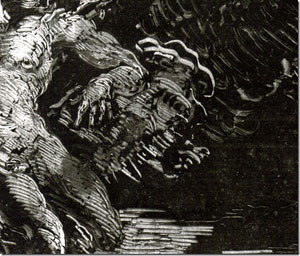Monotype
Monotype
has also been called “the painterly
print”. As its name suggests, it
is special among printmaking techniques
in producing (in general) a single impression.
There is no permanent matrix, reprintable
in identical impressions. The image has
the style, immediacy and uniqueness of
the painted sketch. The printed image is
transferred from an ephemeral drawing.
The artist paints his design with printing
inks onto a copper or glass plate. Fresh
paper is placed on top and the image is
printed by hand pressure in a similar way
to a colour woodcut. Most of the ink is
transferred in the initial printing and
it is only rarely that a second impression
is possible, and then it
reads as a pale ghost of the first (known
as a maculature).
 |
|
Giovanni
Battista Castiglione (1616-1670):
Detail
from one of his ‘dark-field’
monotypes,
c1642 |
|
|
Though
largely a modern colour technique, monotype
was first used in the 17th century to exploit
painterly chiaroscuro effects in monochrome.
It was possibly Rembrandt’s experiments
with tonal inking of some of his etchings
that inspired his Genoese admirer Giovanni
Benedetto Castiglione (see detail,
left)
to make his twenty-two known monotypes
between the years 1640 and 1660. However,
Castiglione’s own etchings are clean-wiped
with an open line, with none of the dramatic
effects of his monotypes. Castiglione worked
in both the ‘dark-field’ and ‘light-field’ manners.
In dark field, the artist coats the surface
of the plate with ink and conjures up his
image by thinning and wiping the ink away
with rags or stiff brushes, in a reductive
manner like mezzotint. In light field the
design is painted additively onto the copper
surface. Castiglione had no immediate followers.
Monotype
was independently re-discovered in the
1870’s. In the 1860’s Adolph
Appian and Ludovic Lepic experimented in
printing their etched plates with dramatic
effects of light and dark by manipulating
ink selectively left on the surface. In
the 1870’s Degas worked his whole
image with the ink on the surface of the
copper, with no preliminary etching. Several
of the other Impressionists tried the new
medium, Pissarro, Mary Cassatt, and Gauguin.

Ernest
Laurent (1859–1929): "Reclining Nude".
Colour
monotype, c1900. (160 x 240 mm)
Though
Whistler never made monotypes, he etched
the Venice set (1879-80) with minimal lines
and printed the impressions with much varied
plate tone to arrive at atmospheric effects
related to monotype. Whistler was friendly
in Venice with his compatriots Frank Duveneck
and Otto Bacher, who were experimenting
with monotype at the time and took the
technique back to America, where it has
been most extensively practised.
In
England the technique was not widely tried
till the 1940’s and 50’s but
the Grosvenor School artists, Cyril Power
and Sybil Andrews, anticipated the interest
in the early 1930’s and exhibited
colour monotypes alongside their colour
linocuts.

Frank
L Emanuel (1865–1948):
"A lowering Afternoon". Monotype, 1920.
(153 x 202 mm)
The
smooth polished surface of copper or glass
takes pigment in a different way to absorbent
canvas or paper and when printed these
textural variations in brushmark and ink
thickness become significant marks unattainable
in any other technique; a confirmation
of printmaking as a distinctive artistic
medium for the creation of original works
of arts and not just a way of obtaining
multiple impressions. |